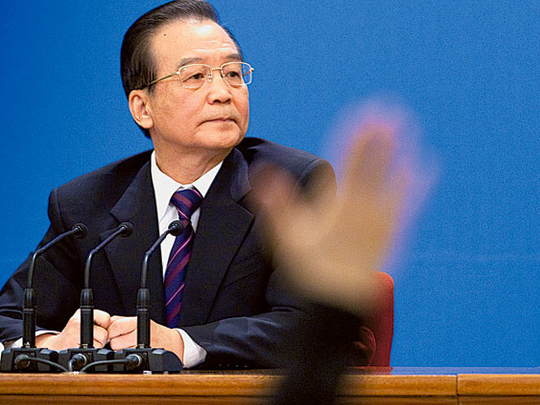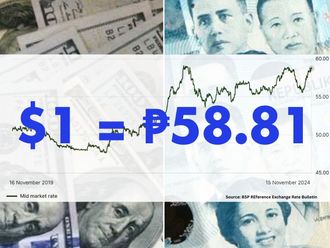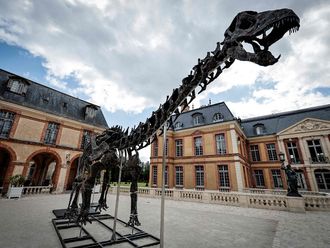
Beijing: Premier Wen Jiabao has an unspoken message to his Group of 20 counterparts in Mexico on Monday: This time, don’t count on a growth bailout from China.
In the depths of the 2008 credit crunch, Wen’s 4 trillion yuan (Dh2.3 trillion) fiscal injection over two years and 17.6 trillion yuan credit surge helped prop up the global economy. In China, it fuelled a property bubble, stoked inflation and amassed bad debts that Fitch Ratings says weakened the banking system.
“The government is trying to strike a better balance between stabilising growth in the short term and adjusting structure in the long term,” said Peng Wensheng, chief economist in Beijing at China International Capital Corp, who worked at the International Monetary Fund and Hong Kong’s central bank. Total stimulus this year may be less than one-third the size of the 5.4 trillion yuan fiscal and monetary firepower of 2009, Peng said.
Investment is more strategically focused than the efforts that year that helped cushion everyone from Australian iron-ore exporters to General Motors Co, which saw its Chinese sales soar 67 per cent as it coped with bankruptcy at home. Of some 818 billion yuan in projects recently approved, 55 per cent were for clean energy or subsidies for fuel-efficient cars, according to Australia and New Zealand Banking Group Ltd.
Hydropower approvals
China has accelerated approvals for wind farms, hydropower plants, airports and steel mills endorsed in its five-year plan through 2015. The government released 66 billion yuan in funding for 2.3 million low-cost houses, and will allocate a 26.5 billion yuan subsidy for eco-friendly household appliances and 6 billion yuan to stimulate sales of energy-efficient vehicles.
Policy makers have relaxed lending rules for banks and expanded loans for first-home buyers to try to support the property market without fuelling the speculation that drove up house prices in 2009. A report on Monday showed that China’s home prices fell in a record 54 of 70 cities tracked by the government in May as developers cut prices to boost sales.
While the approach is boosting sales prospects for solar-panel producer Suntech Power Holdings Co, automaker Great Wall Motor Co and household-equipment supplier Hisense Electric Co, it provides less help for a global economy hit by Europe’s debt crisis. G20 leaders have pressed Europe for a stronger response ahead of their two-day summit in Los Cabos, Mexico, starting on Monday.
Yuan appreciates
The leaders gather a day after a Greek election that’s projected to have yielded enough seats for pro-bailout political parties to forge a parliamentary majority. The result eased immediate concern that Greece is headed for an imminent exit from the euro, and the currency rose 0.4 per cent to $1.2687 as of 11.54am in Tokyo.
China is confident Europe is able to solve its own problems, Vice Finance Minister Zhu Guangyao told reporters in Los Cabos late on Sunday. Zhu said his nation’s economy faces great downside pressure, and the current main task is to stabilise growth. He declined to specify China’s contribution to an increase in IMF resources ahead of the summit.
China’s “recent policy support is an effort to trim the downside risk and sustain overall growth at about 8 per cent, not a major stimulus that would ‘save’ the world economy as in 2009,” said Wang Tao, an economist at UBS AG in Hong Kong. China’s gross domestic product rose 8.1 per cent in January-to-March from a year before, the least in almost three years.
Deposit leeway
Monetary policy has also been deployed, this time with a twist. The central bank cut interest rates on June 7 for the first time since 2008. Accompanying the quarter-point cut, lenders were given greater leeway to set rates on deposits, a step that US negotiators had urged as a component of needed financial deregulation in the world’s second-largest economy.
“Such reforms should allay concerns that the government, spooked by bad economic data, would be narrowly focused on short-term stimulus measures while neglecting long-term reforms,” said Fred Hu, a former chairman for Greater China for Goldman Sachs Group Inc. “The latest announcement by the Chinese central bank sent a positive and reassuring signal for a well-balanced policy package.”
After industrial production gains slumped to a three-year low in April and exports and imports rose less than estimated, the State Council said in a statement on May 23 it would take measures to expand demand and introduce policies to create “stable and relatively fast economic growth”.
‘Unsustainable’ stimulus
There is no plan for stimulus on the scale of 2008 because that is “unsustainable”, the state-run Xinhua News Agency reported May 29. China’s banks are weaker in terms of capitalisation compared with other emerging-market lenders due to the stimulus provided through credit growth in 2009-10, Andrew Colquhoun, head of Asia Pacific sovereign ratings at Fitch, said in Singapore June 13.
China’s economy grew 9.2 per cent in 2009, when global GDP contracted. By comparison, Chinese expansion this year is estimated by the IMF at 8.2 per cent, with world GDP up 3.5 per cent. China’s contribution to global growth may fall to about 30 per cent in 2012, from 36 per cent last year, says Pieter Bottelier, a professor of China studies at Johns Hopkins University in Washington who formerly worked for the World Bank.
“The rate cut is an indication of greater policy engagement but not a harbinger of an ‘all in’ policy response,” said Ramin Toloui, Pacific Investment Management Co’s co-head of emerging markets portfolio management in Singapore. “The macro impact will be moderate and we still expect growth in the mid-7 per cent area for 2012.”
Lending jump
There are indications the accelerated projects are beginning to have an impact. New loans surged to 793.2 billion yuan in May, the highest for that month on record, pointing to a rebound in lending in late May as banks and borrowers responded to the government's initiatives, according to Capital Economics Ltd. HSBC Holdings Plc said new loans may rise to as much as 1 trillion yuan this month.
The world’s largest solar-panel makers are boosting production this year in anticipation that demand in China will double, according to estimates by Bloomberg New Energy Finance.
The five biggest producers of polysilicon solar modules, led by China’s Suntech Power and Yingli Green Energy Holdings Co, will increase shipments 27 per cent to 37 per cent from 2011 levels, according to the average of estimates compiled by Bloomberg. Yingli, China’s second-biggest solar-panel maker, said May 30 it expects domestic sales to gain by 36 per cent this year as the country’s subsidy programme accelerates.
Energy savers
Shares in Great Wall Motor advanced 6.4 per cent May 29 as it was named among auto companies that may benefit from government subsidies, according to BNP Paribas SA. Hisense Electric, China’s biggest manufacturer of flat-panel televisions, climbed to a one-month high the same day after the Ministry of Finance said the nation will subsidise the use of energy-saving appliances.
The strategy of limiting stimulus may come under pressure from provincial governments, especially if Europe's debt crisis deepens. Yao Wei, a Hong Kong-based economist at Societe Generale SA, said the rush of project approvals in May, including the green light for two new steel mills in Guangdong and Guangxi provinces, creates a sense of “deja vu”.
“You can quite easily imagine a scenario where China approves a few too many projects and growth comes in at 9 per cent,” said Alistair Thornton, an economist with IHS Global Insight in Beijing. “That would be fantastic in the short term but in the medium term problems would rear their head even more greatly.”
Firepower remains with its benchmark lending rate at 6.31 per cent and a central government debt-to-GDP ratio less than one-third the US level, China has wherewithal to hit both the monetary and fiscal accelerators if needed. More than one-fifth of the economy is still based on exports, leaving it vulnerable to any 2008-09 type of contraction in global commerce.
“Should Europe implode into a disorderly break-up — still an unlikely outcome — China has plenty of ammunition in its monetary and fiscal policy arsenal to counter the risks,” said Stephen Roach, a professor at Yale University and former non- executive chairman for Morgan Stanley in Asia.
So far, policy makers are holding the line. Guangdong province must close 16 million tonnes of existing steel capacity to compensate for a new plant approved for Baosteel Group Corp while Wuhan Iron & Steel Group’s facility in Guangxi must eliminate 10.7 million tonnes, the National Development and Reform Commission said in statements on May 25.
Greener plants
“If you look carefully at the so-called accelerated approval of investment projects, I argue most will have long-term implications in driving out the polluting and inefficient existing production,” said Li Daokui, a former central bank adviser. The new mills will be “more efficient and greener” than current plants in Beijing, Shandong and Hebei, Li said.
Support for real estate, which UBS estimates accounts for more than a quarter of final demand, has helped to revive the property market. After banks lowered mortgage rates for first- home buyers, transactions in Beijing rose 30 per cent in May from the previous month, to 23,174 units, the highest since the Chinese capital imposed property controls in February last year, Centaline Property Agency Ltd said in a June 1 report.
The government still has a “no mercy” stance toward speculators because it doesn’t want home prices to climb, Societe Generale’s Yao said.
“Policy makers want to engineer an era of better-quality growth based on higher consumption and lower energy-consuming and polluting production,” Jim O’Neill, chairman of Goldman Sachs Asset Management in London, wrote in a June 2 note to clients. “I think it unwise for people to expect another big infrastructure-based stimulus.”












